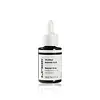What's inside
What's inside
 Key Ingredients
Key Ingredients

 Benefits
Benefits

 Ingredients Side-by-side
Ingredients Side-by-side

Water
Skin ConditioningButylene Glycol
HumectantGluconolactone
Skin Conditioning1,2-Hexanediol
Skin ConditioningSodium Citrate
BufferingBetaine
HumectantLactobionic Acid
BufferingXylitol
HumectantSaccharide Isomerate
HumectantTrehalose
HumectantPanthenol
Skin ConditioningDipotassium Glycyrrhizate
HumectantAloe Barbadensis Leaf Juice Powder
Skin ConditioningCentella Asiatica Extract
CleansingAllantoin
Skin ConditioningGlycyrrhiza Glabra Root Extract
BleachingScutellaria Baicalensis Root Extract
AstringentArtemisia Montana Leaf Extract
Skin ConditioningPolygonum Cuspidatum Root Extract
AntioxidantFructan
Skin ConditioningSodium Polyglutamate
HumectantVaccinium Corymbosum Fruit Extract
Skin ConditioningCamellia Sinensis Leaf Extract
AntimicrobialChamomilla Recutita Flower Extract
MaskingGinkgo Biloba Leaf Extract
Skin ConditioningRosmarinus Officinalis Leaf Extract
AntimicrobialRosa Canina Fruit Oil
EmollientEthylhexylglycerin
Skin ConditioningXanthan Gum
EmulsifyingWater, Butylene Glycol, Gluconolactone, 1,2-Hexanediol, Sodium Citrate, Betaine, Lactobionic Acid, Xylitol, Saccharide Isomerate, Trehalose, Panthenol, Dipotassium Glycyrrhizate, Aloe Barbadensis Leaf Juice Powder, Centella Asiatica Extract, Allantoin, Glycyrrhiza Glabra Root Extract, Scutellaria Baicalensis Root Extract, Artemisia Montana Leaf Extract, Polygonum Cuspidatum Root Extract, Fructan, Sodium Polyglutamate, Vaccinium Corymbosum Fruit Extract, Camellia Sinensis Leaf Extract, Chamomilla Recutita Flower Extract, Ginkgo Biloba Leaf Extract, Rosmarinus Officinalis Leaf Extract, Rosa Canina Fruit Oil, Ethylhexylglycerin, Xanthan Gum
Ingredients Explained
These ingredients are found in both products.
Ingredients higher up in an ingredient list are typically present in a larger amount.
Camellia Sinensis Leaf Extract is derived from the leaves of the tea plant. Black tea, green tea, and oolong tea are all harvested from this plant.
This ingredient has many skin benefits:
This ingredient contains polyphenols, a strong antioxidant. Antioxidants help fight off molecules that damage skin cells.
On top of that, the antioxidants in green tea neutralize free-radicals from the sun. This gives the skin some extra UV protection, but should not replace sunscreen.
Many components of tea have anti-inflammatory properties.
Polyphenols and L-theanine help soothe the skin and reduce irritation. The caffeine in Camellia Sinensis Leaf Extract helps calm inflamed blood vessels.
Other compounds found in tea include: Vitamin Bs, linoleic acid, magnesium, calcium, iron, and zinc.
Research has shown both drinking Camellia Sinensis Leaf Tea and applying it to the skin can help boost skin elasticity and hydration. Studies also show using tea extract may reduce sebum, or oil, production.
Learn more about Camellia Sinensis Leaf ExtractCentella Asiatica Extract (Centella) is derived from an herb native to Southeast Asia. It is famous for its anti-inflammatory and soothing properties.
Centella is rich in antioxidants and amino acids, such as Madecassic Acid and Asiaticoside.
Studies show the compounds in centella help with:
The combination of all these properties makes centella effective at soothing, hydrating, and protecting the skin.
Other great components of centella include Vitamin A, vitamin C, several B vitamins, and Asiatic Acid.
Fun fact: Centella has been used as a medicine and in food for many centuries. As a medicine, it is used to treat burns, scratches, and wounds.
Learn more about Centella Asiatica ExtractDipotassium Glycyrrhizate comes from licorice root.
Extracts of licorice have demonstrated to have antibacterial, anti‐inflammatory, antiviral, antioxidant properties.
One component, glabridin, has extra potent antioxidant and soothing properties. It has also been found to block pigmentation from UVB rays in guinea pigs.
Licorice Root also contains a flavonoid. Flavonoids are a natural substance from in plants. Flavonoids also have antioxidant properties.
Another component, glycyrrhizin, has been found to have anti-inflammatory and antimicrobial benefits. This may make licorice root extract effective at treating acne. However, more research is needed to support this.
Liquiritin is one of the flavone compounds found in licorice. It has been found to help lighten skin by preventing tyrosinase from reacting with tyrosine. When the two react, protein is converted to melanin. Melanin is the substance in your body that gives your features pigmentation.
Licorice root is native to Southern Europe and Asia. It has been used in traditional Chinese medicine to help with respiratory issues.
Learn more about Dipotassium GlycyrrhizatePolygonum Cuspidatum Root Extract comes from the Japanese Knotweed plant native to Japan, Korea, and China.
This plant contains anti-inflammatory and antioxidant properties. It contains high amounts of resveratrol, a potent antioxidant.
The root of the plant has been used in traditional folk medicine throughout Asia.
Learn more about Polygonum Cuspidatum Root Extract